
The first HMS Wivern was an ironclad turret ship built at Birkenhead, England. She was one of two sister ships secretly ordered from the John Laird Sons & Company shipyard in 1862 by the Confederate States of America.
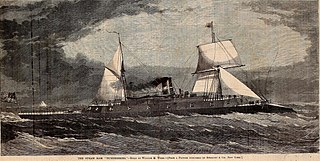
Dunderberg, which is a Swedish word meaning "thunder(ing) mountain", was an ocean-going casemate ironclad of 14 guns built for the Union Navy. She resembled an enlarged, two-masted version of the Confederate casemate ironclad CSS Virginia. She was originally designed to have both gun turrets and a casemate but the turrets were deleted while the ship was still being built. Construction began in 1862, but progress was slow and she was not launched until after the end of the American Civil War in 1865.

An ironclad is a steam-propelled warship protected by iron or steel armor plates, constructed from 1859 to the early 1890s. The ironclad was developed as a result of the vulnerability of wooden warships to explosive or incendiary shells. The first ironclad battleship, Gloire, was launched by the French Navy in November 1859 – narrowly pre-empting the British Royal Navy, though Britain built the first completely iron-hulled warships.
HMS Valiant was the second ship of the Hector-class armoured frigates ordered by the Royal Navy in 1861. Her builders went bankrupt shortly after she was laid down, which significantly delayed her completion. After being launched in 1863, she waited a further five years to receive her guns due to supply issues. Upon being commissioned in 1868 the ship was assigned as the First Reserve guard ship for Southern Ireland, where she remained until she was decommissioned in 1885. Valiant was hulked in 1897 as part of the stoker training school HMS Indus before becoming a storeship for kite balloons during the First World War. The ship was converted to a floating oil tank in 1926 and served in that role until sold for scrap in 1956.

HMS Minotaur was the lead ship of the Minotaur-class armoured frigates built for the Royal Navy during the 1860s. Minotaur took nearly four years between her launching and commissioning because she was used for evaluations of her armament and different sailing rigs.
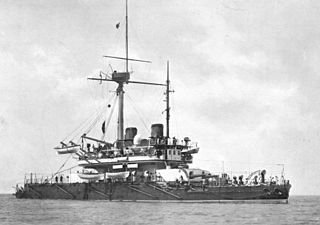
HMS Thunderer was one of two Devastation-class ironclad turret ships built for the Royal Navy in the 1870s. She suffered two serious accidents before the decade was out and gained a reputation as an unlucky ship for several years afterward. The ship was assigned to the Mediterranean Fleet in 1878 and was reduced to reserve in 1881 before being recommissioned in 1885. Thunderer returned home in 1887 and was again placed in reserve. She rejoined the Mediterranean Fleet in 1891, but was forced to return to the UK by boiler problems the following year. The ship became a coast guard ship in Wales in 1895 and was again placed in reserve in 1900. Thunderer was taken out of service in 1907 and sold for scrap in 1909.

The two Scorpion-class ironclads, HMS Scorpion and HMS Wivern, were ironclad warships ordered by the Confederate States Navy in 1862 and seized in 1863 by the British to prevent their delivery. This would have violated the Foreign Enlistment Act, which forbade British subjects to build or arm any ships for governments at war with governments friendly to Great Britain. The Scorpion class were masted turret ships, each with two gun turrets that were designed to mount a pair of heavy muzzle-loading guns. They were purchased for service in the Royal Navy in 1864 and served briefly with the Channel Fleet before they became guard ships at Bermuda and Hong Kong. Scorpion was sold in 1903 and sank under tow to be scrapped, while Wivern was sold for scrap in 1922.

HMS Inflexible was a Victorian ironclad battleship carrying her main armament in centrally placed turrets. The ship was constructed in the 1870s for the Royal Navy to oppose the perceived growing threat from the Italian Regia Marina in the Mediterranean.
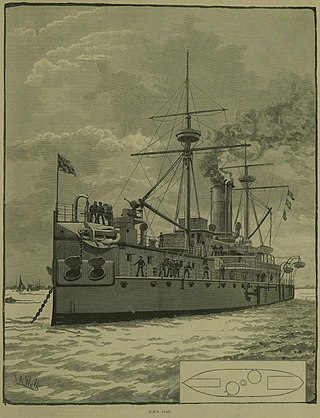
HMS Ajax was the name ship of her class of ironclad battleships built for the Royal Navy during the 1870s. Completed in 1883, she was immediately placed in reserve until 1885 when the ship was commissioned for the first time. Later that year, Ajax was assigned as a coast guard ship in Scotland and remained there for the next six years. She was reduced to reserve again in 1891 and was taken out of service a decade later. The ship was sold for scrap in 1904 and subsequently broken up.

Rolf Krake was a Danish turret ironclad built in Scotland during the 1860s. The vessel was designed by Cowper Phipps Coles, a pioneering naval architect, and was the first warship of any navy to carry a turret of the type designed by Coles. She was the first all-iron, steam-powered vessel acquired by Denmark.

The Brazilian monitor Bahia was originally ordered by Paraguay in 1864 with the name Minerva, but was sold to Brazil when Paraguay defaulted on the payments. She participated in the 1864–70 War of the Triple Alliance between Brazil, Argentina and Uruguay against Paraguay, and took part in the Passage of Humaitá.

The Spanish ironclad Tetuán was an armored frigate built in the royal dockyard at Ferrol during the 1860s for the Spanish Navy. She was captured by rebels during the Cantonal Revolution in 1873 and participated in the Battle off Cartagena. While under repair after the battle, the ship was destroyed by fire and broken up in 1874.
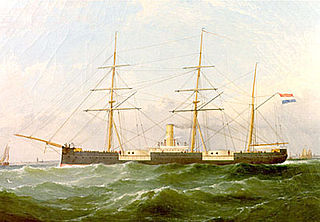
HNLMS Prins Hendrik der Nederlanden was an ironclad ramtorenschip built in Great Britain for the Royal Netherlands Navy in the mid-1860s. She was transferred to the Dutch East Indies in 1876 and participated in the Dutch intervention in Lombok and Karangasem in 1894. The ship was hulked in 1899 and scrapped in 1925.

The Russian ironclad Kniaz Pozharsky was an iron-hulled armored frigate built for the Imperial Russian Navy during the 1860s. She was the first Russian armored ship to leave European waters when she cruised the Pacific Ocean in 1873–75. The ship did not participate in the Russo-Turkish War of 1877–78, and remained in the Baltic Sea until 1879–80, when she made another cruise to the Pacific. Kniaz Pozharsky was assigned to the Baltic Fleet for the rest of her career. She mainly served as a training ship after her refit in 1885 until she was hulked in 1909 and probably scrapped in 1911.

Smerch was a monitor built for the Imperial Russian Navy in the early 1860s. She was designed by the British shipbuilder Charles Mitchell and built in Saint Petersburg. The ship spent her entire career with the Baltic Fleet. She ran aground and sank shortly after she entered service in 1865. Smerch was refloated and repaired shortly afterwards. She became a training ship sometime after 1892 and was stricken from the Navy List in 1904. The ship was hulked five years later and renamed Blokshiv No. 2. She was in Finland when that country declared its independence in 1918, but was returned to the Soviets after the Treaty of Brest-Litovsk was signed. Blokshiv No. 1, as the ship was now known, was sunk by German artillery fire in 1941. She was salvaged the following year and remained in service until she was stricken in 1959 and subsequently broken up.

The Admiral Spiridov class were a pair of monitors built for the Imperial Russian Navy in the late 1860s. The sister ships were assigned to the Baltic Fleet upon completion and remained there for their entire careers. Aside from several accidental collisions and one grounding, their careers were uneventful. They were reclassified as coast-defense ironclads in 1892 before they became training ships in 1900. The Admiral Spiridovs were stricken from the Navy List in 1907; one ship became a stationary target and the other a coal-storage barge. Their ultimate fates are unknown.

The Kalamazoo-class monitors were a class of ocean-going ironclad monitors begun during the American Civil War. Unfinished by the end of the war, their construction was suspended in November 1865 and the unseasoned wood of their hulls rotted while they were still on the building stocks. If the four ships had been finished they would have been the most seaworthy monitors in the US Navy. One was scrapped in 1874 while the other three were disposed of a decade later.

HNLMSStier was a Schorpioen-class monitor built in England for the Royal Netherlands Navy in the 1860s.
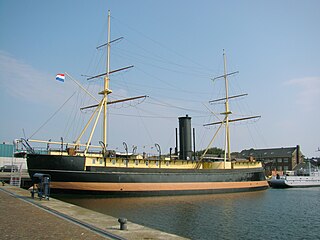
The Schorpioen-class monitors were a pair of ironclad monitors built abroad for the Royal Netherlands Navy in the 1860s. They had uneventful careers and were stricken from the Navy List in the first decade of the 20th century. Stier became a target ship and was sunk in 1925. Schorpioen was converted into an accommodation ship in 1909. She was captured by the Germans during World War 2, but survived the war. She remained in service until 1982 and then became a museum ship.

The Buffel-class monitors were a pair of ironclad monitors built for the Royal Netherlands Navy in the 1860s. They had uneventful careers and were stricken from the Navy List in the late 1890s. Guinea was scrapped in 1897, but Buffel was hulked and converted into an accommodation ship in 1896. She was captured by the Germans during World War II, but survived the war. She became a museum ship in 1979.



















